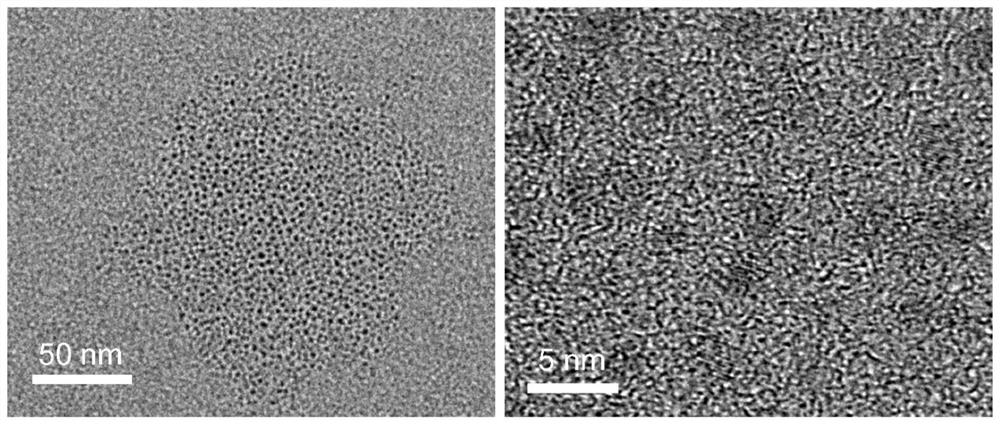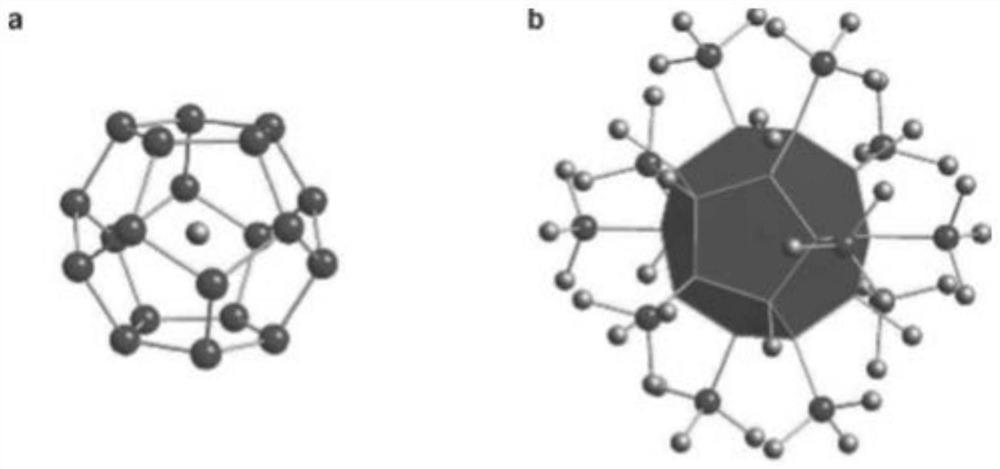Method for preparing sub-nano silicon-carbon composite material by liquid phase method
A silicon-carbon composite material and sub-nanometer technology, applied in nano-carbon, silicon compounds, nanotechnology and other directions, can solve the problem that it is difficult to easily obtain a sub-nano-sized silicon-carbon composite material, and the growth and deposition of silane gas into silicon particles cannot be precisely controlled. , it is difficult to realize the preparation of sub-nano-sized silicon materials, etc., to achieve the effect of improving high energy density, easy to enlarge the method, and stable structure
- Summary
- Abstract
- Description
- Claims
- Application Information
AI Technical Summary
Problems solved by technology
Method used
Image
Examples
Embodiment 1
[0025] Step (1): HSiCl 3 and ethylenediamine were dissolved in acetonitrile in a mass ratio of 5:1, and stirred at room temperature for 10 hours to obtain a yellow solution;
[0026] Step (2): Mix and react the yellow solution in step (1) with 0.1 mol of amylmagnesium bromide, stir at room temperature for 2 hours, and purify to obtain a mixed solution of organic group-modified silicon clusters;
[0027] Step (3): The mixed solution in step (2) was pumped dry under reduced pressure to obtain a yellow solid, which was placed in a tube furnace and heat-treated at 500°C for 2 hours under the protection of flowing high-purity argon. After cooling, The subnano-silicon-carbon composite material was prepared.
Embodiment 2
[0029] Step (1): HSiCl 3 and ethylenediamine were dissolved in tetrahydrofuran in a mass ratio of 5:1, and stirred at room temperature for 10 hours to obtain a yellow solution;
[0030] Step (2): Mix and react the yellow solution in step (1) with 0.1 mol of amylmagnesium bromide, stir at room temperature for 2 hours, and purify to obtain a mixed solution of organic group-modified silicon clusters;
[0031] Step (3): The mixed solution in step (2) was pumped dry under reduced pressure to obtain a yellow solid, which was placed in a tube furnace and heat-treated at 500°C for 2 hours under the protection of flowing high-purity argon. After cooling, The subnano-silicon-carbon composite material was prepared.
Embodiment 3
[0033] Step (1): Si 2 Cl 6 and ethylenediamine were dissolved in acetonitrile in a mass ratio of 5:1, and stirred at room temperature for 10 hours to obtain a yellow solution;
[0034] Step (2): Mix and react the yellow solution in step (1) with 0.1 mol of amylmagnesium bromide, stir at room temperature for 2 hours, and purify to obtain a mixed solution of organic group-modified silicon clusters;
[0035] Step (3): The mixed solution in step (2) was pumped dry under reduced pressure to obtain a yellow solid, which was placed in a tube furnace and heat-treated at 500°C for 2 hours under the protection of flowing high-purity argon. After cooling, The subnano-silicon-carbon composite material was prepared.
PUM
 Login to View More
Login to View More Abstract
Description
Claims
Application Information
 Login to View More
Login to View More - R&D
- Intellectual Property
- Life Sciences
- Materials
- Tech Scout
- Unparalleled Data Quality
- Higher Quality Content
- 60% Fewer Hallucinations
Browse by: Latest US Patents, China's latest patents, Technical Efficacy Thesaurus, Application Domain, Technology Topic, Popular Technical Reports.
© 2025 PatSnap. All rights reserved.Legal|Privacy policy|Modern Slavery Act Transparency Statement|Sitemap|About US| Contact US: help@patsnap.com


